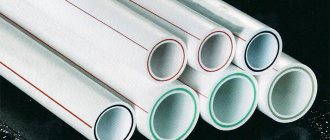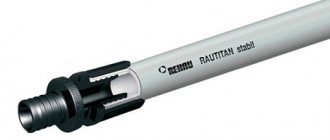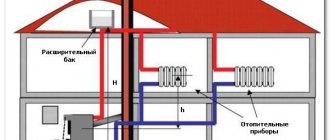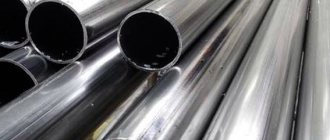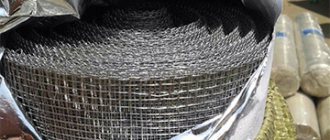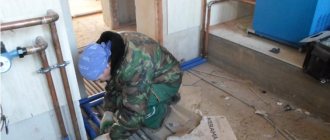How to insulate pipes in the basement with your own hands
Insulating a pipe with mineral wool with your own hands
Insulating a pipe with mineral wool
Stage 1
For plastic heating pipes, it is best to use mineral wool or glass wool. Take a roll of cotton wool, unwind it and cut off small pieces. Wrap it around the water pipe and secure it with a nylon rope. To do this, wrap and tie a rope on one side of the pipe, and in a spiral, wrap it all the way around the pipe and tie the rope securely - this is the initial insulation.
Stage 2
Waterproof the water pipe. To do this, take a roll of roofing felt and cut small pieces of 2-3 m each. Wrap the heating pipe around the top of the insulation. Try to make overlaps of at least 10 cm. Take the nylon rope again, tie it at one end and also wrap it around the heating or water pipe in a spiral. Additionally, the insulation can be wrapped with tape.
Pipe insulation with polystyrene foam
Pipe insulation with polyurethane foam
Take a polyurethane foam “shell” and connect the two halves around the pipe, wrap the edge with tape. Place the following parts “overlapping” by about 10-20 cm. Wrap the shell with tape at the junction. The insulation may have a layer of foil, which makes it similar to a thermos. This insulation can be used in the basement and outdoors.
Pipe insulation with polystyrene foam
Insulation with polystyrene foam is the most affordable material. Expanded polystyrene “shells” are produced for different pipe diameters; installation is easy and at the lowest cost. Take the insulation halves, connect it around the pipe and wrap it with tape. Carry out this operation until the entire pipe is covered with insulation.
How to insulate water pipes in the basement of a private house from freezing
Water supply in an apartment building, private house or country cottage is a common occurrence; water should be available at any time of the year. However, temperature fluctuations can make significant adjustments to the water supply process.
Insulation of external water supply in a private house
Apartment owners think little about how the water supply is organized, and owners of private houses are forced to take steps on their own to ensure that the water in the pipes does not freeze in winter. At the same time, we note that frost does not spare either steel or plastic pipes. The only way to keep water in liquid form and prevent damage to the water supply system is to fully insulate the water pipes. After all, unlike a heating pipe system, there is no warm medium.
Due to the fact that thermal insulation is carried out on your own site, we are not talking about an industrial scale of work, which means it makes sense to study how to insulate water pipes with your own hands.
If the pipes are laid below the soil freezing level - no, if above - yes.
The depth of the water pipeline is regulated by SNiP 2.04.02-84.
Depth of water supply SNiP 2.04.02-84 and SP 40-102-2000, MSP 4.01-101-2000
Let’s make a reservation right away that laying pipes at the correct depth neutralizes the effects of low temperatures; the material in this article is focused on those cases where, for certain reasons, the water supply system was buried at a shallow depth.
- increasing pressure in the water supply system;
- cable for heating a water pipe;
- thermal insulation for water supply pipes.
The water pipe will not freeze because the water will move at high speed. To implement this method, a pump is used to increase the pressure in the water supply system or a receiver that cuts into the pipe directly next to the pump.
Cable power 10-15 W (average price – 15 USD/m.p.). Excellent for heating pipes in the ground when they are placed at a shallow depth. According to the rules, it is not advisable to place any communications in the soil below the soil freezing level. There are situations in which this requirement is ignored. In this case, simple insulation of pipes will not give the desired result, because... the pipeline will in fact be located in water (in a humid environment that freezes in winter). Most of the insulation materials are not suitable for this mode of operation and do not provide proper thermal insulation.
Using a cable to heat the water supply makes it possible to lay pipes at a depth of up to 500 mm.
Heating cable for water pipe
The heating cable for insulating water pipes is wound along the pipe or around it with a given pitch. The pitch is determined by the power of the cable. The lower the power, the smaller the step. Methods for laying the heating cable are shown in the diagram.
Wiring diagram for installing a cable for heating a water pipe
Craftsmen and users note that insulating a water supply system by heating the pipe with a cable is the most reliable method for protecting pipes laid in the ground freezing zone.
Cable heating makes it possible to avoid freezing of water in the pipe, and, equally important, to quickly defrost frozen pipes. Such a need may arise at a dacha if it is intended for seasonal living. In this case, you can quickly prepare the pipeline for operation, because under natural conditions you can wait until May for complete defrosting (when laying pipes at the level of soil freezing). The cable is located both inside and outside the water supply pipe.
This is the most cost-effective and easiest insulation method from the point of view of independent implementation. Let's look at it in more detail. Let's start with the best way to insulate a water supply system, what materials can be better used depending on specific conditions.
It is not difficult to get confused in the wide range of thermal insulation materials. To choose the best option, you need, at a minimum, to know the main types and types, key characteristics and features.
Thermal insulation of water pipes is carried out with various insulation materials, which are grouped below (in the form of a classification) according to the principle of unity of insulation technology.
Types, types, varieties and rules for choosing pipe insulation.
This category includes polystyrene foam, polystyrene foam (2560-3200 rubles/cube) and Penoplex (3500-5000 rubles/cube), thermal insulation properties and price depend on density.
Polystyrene foam is an excellent insulator and has a relatively low cost (compared to other materials). However, it is quite difficult to insulate a round pipe with a rigid insulation board. To insulate pipes, special shells (hard boxes) are used - shells in which pipes are placed, and the space is filled with soft insulation.
Laying water pipes in a foam box
This segment includes: polyethylene (as an additional material), foil penofol (50-56 rubles/sq.m.), mineral wool (70-75 rubles/sq.m.) and glass wool (110-125 rubles/sq.m.) ), furniture foam rubber (250-850 rubles/sq.m. depending on thickness).
Insulating water supply pipes with rolled thermal insulation is also fraught with difficulties, which lie in the hygroscopicity of the material. Those. insulation loses its properties when exposed to moisture, which means it has a narrower scope of application, or needs additional protection. Plus, you need to think about how to attach the insulation to the pipe.
Basalt heat-insulating mats and foam rubber for insulation of water pipes
Pipe insulation casing is the most progressive option for pipeline thermal insulation. The shell for insulating the water pipe ensures maximum tightness and, as a result, creates a reliable thermal insulation layer.
There are types of segmental insulation:
Polystyrene foam shells for insulating water pipes are rigid (thermal insulating casing for pipes is a shell made of polystyrene foam (PPU) or foam plastic. Price from 190 rubles/m.p., depends on the thickness and diameter of the cylinder);
The peculiarity of insulation by spraying polyurethane foam is that thermal insulation is applied to the surface of the pipe, ensuring 100% tightness (the cost of components for polyurethane foam filling starts from 3.5 euros per kg). The number of components is determined by the thickness of the fill; work is paid additionally). On average, the cost of insulation with sprayed polyurethane foam is 15-20 dollars/m.p.
Sprayed insulation also includes heat-insulating paint for pipes. You can apply it yourself, because... Thermal paint is sold in aerosol cans. A layer of paint of 20 mm. replaces 50 mm of basalt wool insulation. In addition, this is the only material that is not susceptible to damage from rodents.
Insulation of water pipes by spraying polyurethane foam (PPU) Water pipe insulated with polyurethane foam (PPU)
When choosing thermal insulation material for insulating water supply pipes, you need to take into account the following factors:
- pipeline installation location. Insulation of pipes laid on the ground and located underground is carried out in different ways, even when using the same materials (it is also important to take into account whether the pipes are laid before or below the freezing level);
- frequency of pipeline operation. For example, in a country house that is not intended for permanent residence, it is enough to simply avoid a pipe rupture. To do this, a receiver is installed or the water supply is insulated with a cable. But in a private house it is necessary to ensure a year-round water supply. Here you need to approach the choice of insulation more carefully;
- thermal conductivity indicator of pipes (plastic, metal);
- resistance to moisture, combustion, biological activity, ultraviolet radiation, etc. determines the need to protect the insulation from these factors;
- ease of installation;
- price;
- life time.
The location of the pipes is another important factor that must be taken into account when choosing insulation. Indeed, depending on where the pipes are located (in the ground, basement, cold attic, unheated room), the temperature and humidity conditions are determined, as well as the ease of installation of the insulation and the need for its additional protection.
Water pipes are rarely laid by air or on the soil surface. Rather, in this case, the part of the pipeline that runs directly under the house or at the junction of the pipe with the pump, meter, or inside the distribution well needs insulation.
The specificity of insulation in this case is such that the pipe is insulated with any insulation that is capable of ensuring a sufficient tightness of the fit and is not exposed to moisture. As a rule, the thickness of the insulation intended for above-ground insulation of pipes is higher than for underground insulation. At this stage, it is important not only to insulate the pipe, but also to ensure protection of the thermal insulation material, in particular from getting wet.
Such insulation will be needed only if the pipes are laid above the soil freezing level. To insulate a pipeline in the ground, you can use any material, including rigid insulation.
It is worth noting that the insulation of external water supply does not end with the installation of insulation. It is important to protect the insulation from getting wet. To do this, a film, roofing material is wound over the main thermal insulation material, or a plastic box is installed.
For installation, prepare: foil tape, thermal insulation material, heating cable (power 20 W per linear meter).
Installing a heating cable on top and inside a water pipe
- the pipe along its entire length (from the well/well to the house) is glued with foil tape;
- The heating cable is laid in a convenient way with the same pitch. For a 20 W cable, a pitch of 100-150 mm will be optimal. For a less powerful cable, the pitch is reduced. The most convenient way to lay the cable is to wrap the pipe in a spiral;
- the cable is fixed with foil tape;
- Insulation is installed on the pipe. Pipes made of foamed polymers, basalt cylinders or polyurethane foam shells are placed on the pipe. In this case, it is necessary to ensure that the diameter of the pipe corresponds to the internal diameter of the segmental insulation. Before starting work, roll insulation is cut into strips, which are wrapped around the pipe and secured with clamps or wire. Their task is to hold the insulation in a given position.
- the insulation is fixed to the pipe with tape (plumbing tape). The tape is wrapped very tightly. The main task of the winding is waterproofing, i.e. prevent groundwater from entering the insulation;
- additionally insulate the pipe at the point where it reaches the soil surface. The following options are offered: additional winding with insulation or arrangement of a box in which the insulation will be placed.
Regardless of the insulation method, it makes sense to choose only high-quality materials and install them according to the instructions. Of course, this affects the budget of the event, but expenses of this kind pay off in the future. And a frosty winter will not bring unpleasant surprises in the form of a lack of water due to freezing in pipes or a rupture in the water supply system.
Preface . Regardless of the material of the pipes laid in the basement of a private or apartment building, steel or metal-plastic - during frosts, with insufficient insulation, frozen water can rupture the water supply. Let's look at the technology for insulating water supply and heating pipes, the requirements for thermal insulation, and also show video instructions on how to independently insulate water pipes in the basement.
The owner of a country house should, even before the onset of cold weather, think about how to properly insulate the pipes in the basement on his own, how to insulate the blind area of the house and the foundation, and what thermal insulation material is best to use for this. The fact is that the water supply system has the most vulnerable areas for freezing; these problem areas are located on the street or in the unheated basement of a residential building.
If insulating a water supply system in the ground is a more labor-intensive issue, then the thermal insulation of water supply pipes in the basement of an apartment building or private building is easier to solve. The main requirements for insulating materials for water pipes are ease of installation, low thermal conductivity and maximum long-term operation of the material in a humid environment, since everyone wants to get the job done quickly and for a long time.
Insulation of metal-plastic pipes in the basement
There are many requirements for pipe thermal insulation, depending on the operating mode of the material - resistance to temperature, chemical and mechanical influences. To begin choosing a suitable pipe insulation, you should list the most important characteristics that you should pay attention to when purchasing:
— maximum service life; — water-repellent ability of thermal insulation; - non-flammability, ability to self-extinguish; — ease of installation, reuse; — low cost of pipe thermal insulation; — environmental safety of the material.
More recently, all kinds of available materials were used to insulate pipes in the basements of houses - foam rubber, cotton blankets, synthetic winterizer, etc. But today the range of modern pipe insulation is quite wide, so it is quite difficult to understand this huge variety on your own. In the next chapter we will consider the most popular thermal insulation materials for work.
Fiberglass insulation , for example, Isover or URSA glass wool, is used more often for thermal insulation of metal-plastic pipes. The advantages of glass wool include the low thermal conductivity of the material, but its use requires additional waterproofing using rolled materials (fiberglass, isolon, glassine or roofing felt), which will require additional financial costs.
Foamed polyethylene pipe insulation
Basalt insulation in the form of cylinders allows you to process water pipes without the additional construction of special trays. Thanks to its cylindrical shape, the insulation is excellent for insulating heating pipes in the basement of a house. The top layer of waterproofing is usually made of foil insulation, but the cost of this insulation can be quite high.
Foam insulation is more common. Expanded polystyrene shells are used for pipes without an external waterproofing coating. A shell made of polystyrene foam or extruded polystyrene foam can be reused many times (it can be easily removed if necessary), and its low cost and ease of installation satisfy all basic requirements.
Foamed polyethylene (Penofol, Izolon, etc.) is a moisture-proof, rot-resistant, elastic material with good thermal insulation properties. For thermal insulation of pipes, the material is supplied in the form of a hollow tube with a cut, which greatly simplifies installation. Pipe insulation made of foamed polyethylene can be used in buildings for various purposes.
Thermal insulation of pipes in the basement of a private house with foamed polyethylene or other materials is the simplest technology that anyone can handle. First of all, it is necessary to prepare water supply or heating pipes for the insulation procedure - clean all treated surfaces from dust or dirt. Thermal insulation of pipes in multi-apartment and private buildings can be done at any time, before and after their installation.
Photo. Insulation of pipes in the basement of a house with mineral wool
Insulating pipes in the basement with mineral wool is the most labor-intensive method. Take a roll of basalt or fiberglass wool and cut it into small pieces. Wrap the mineral wool around the water pipe and secure it with a nylon rope - tie the rope around the insulation on one side of the pipe, then in a spiral circle the rope to the end of the pipe and tie the rope securely on the pipe.
It is necessary to make a waterproofing protection on top of the insulation. Cut a roll of waterproofing (roofing felt, glassine or foil penofol) into pieces of the required size and wrap it over the insulated pipe. You can secure the waterproofing with rope or tape. It is recommended to overlap at least 10 centimeters between the waterproofing joints.
PPU pipe shell for insulation
Insulating pipes in the basement of a house with shells is one of the easiest ways to protect communications from freezing. Pipe insulation from polyurethane foam, polystyrene foam or extrusion is produced for different pipe diameters; the shell may have an outer layer of foil. When choosing between these three materials, mainly pay attention to the cost, since their other characteristics are almost the same.
Installation of the shell on the pipe is easy and cost-effective. To install, take two halves of the shell, connect them around the pipe and secure with tape. Place the following parts on the pipe with an overlap of 10-20 cm over the previous part. The operation is repeated until the entire pipe in the basement of a private house is protected from possible freezing by insulation.
Photo. Insulation of pipes with foamed polyethylene
Pipe insulation made of foamed polyethylene is the simplest and most common way to protect water pipes from freezing in the ground and in the basements of apartment buildings. The material can be installed before laying the pipes, inserting the pipes into a hollow polyethylene foam tube, as well as onto already installed pipes - to do this, you just need to cut the polyethylene foam tube with a knife.
If the pipe insulation was cut for installation, then it is necessary to secure the material to the pipe using plastic clamps, aluminized or regular tape. The main advantage of this heat insulator is that additional waterproofing is not required. In addition, foamed polyethylene can also be used for independent insulation of a gas pipe on the street.
Insulation materials and requirements for heating systems
List of materials used for thermal insulation of pipelines:
- mineral wool;
- expanded polystyrene;
- penoizol;
- foamed polyethylene;
- polyurethane foam;
- penofol.
Not only the main main pipelines are subject to insulation, but also the heating pipes of private and apartment buildings located in the basement, cellar, roof, street. Modern insulation materials are developed from inexpensive materials, with an ergonomic design that helps process pipes without the help of professionals and special tools.
Insulation for heating and hot water supply pipes - material requirements:
- Low thermal conductivity.
- Safety for humans and the environment.
- Inert to acids, alkalis and other biological substances.
- Non-flammable material.
- High melting point.
- Low hygroscopicity.
- High corrosion resistance.
- Durability.
- Economical.
- Easy installation.
Requirements for insulation for pipe insulation
More recently, any available material was used for pipes - old jackets, cotton blankets, etc. Today the range of insulation is so wide that making the right choice is not so easy. Therefore, the most popular materials should be considered, as well as the technological requirements for these materials. Let's consider what to consider when choosing insulation:
- Duration of operation of the insulating material;
- Insulation resistance to high humidity and moisture;
- Fire safety and fire resistance of insulation;
- Easy installation with the possibility of reuse;
- Resistance to mechanical and temperature influences;
- Low cost and availability of pipe insulation.
Why do you need insulation for attic ventilation?
The ventilation system is designed to maintain a certain level of humidity and temperature in the room. It also needs insulation. This is especially true for the attic in winter, when the pipes are very hot from the inside and are blown with cold air from the outside.
Then condensation appears on the surface, which can damage the material. Proper insulation will reliably protect the structure and prevent negative consequences. This applies not only to pipes, but to the entire ventilation system as a whole. In addition, it will help save energy, which is also an important factor in favor of insulation.
PPU insulated pipes
We insulate heating pipes and ventilation in the attic
What is thermal insulation of pipes and why is it necessary? The main part of the house's communications are located on the street or in technical rooms, such as the basement or attic floor. Such types of premises are not residential, which means they are more prone to unfavorable environmental climate conditions.
Various temperature changes do not benefit pipelines and ventilation, which, due to their purpose, must constantly work. To increase the life and quality of their service, you need to worry about insulation.
Insulating pipes in the attic is a necessary measure
Heating pipes in the attic are prone to extreme temperatures. Due to this, due to the plus in the middle and minus on the outside, small cracks can appear in the pipe, which gradually destroy the material. To protect communications from destructive processes, it is worth considering their good insulation.
Types of heat insulators for pipes
- Minvata. An insulating material that is great for insulating pipes with a hot coolant in the middle. Available in 2 variations: in the form of rolls or mats. It is not prone to deformation due to sudden temperature changes, is difficult to ignite, and is resistant to the influence of a wide variety of chemical-based substances. The disadvantages usually include a fairly high price and a tendency to accumulate moisture in the middle.
- Foamed polyethylene. It looks like a tube with a cut of various diameters. The outside is covered with foil. Multifunctional material. Suitable for a wide variety of pipes and all types of premises. Resistant to critical temperatures. It can perfectly allow air to pass through due to micropores.
- Foamed rubber. Similar to the previous type of insulating material, but has greater resistance to fire. The outside is covered with foil.
- Thermal paint. One of the simplest and most multifunctional methods of insulation. Apply to the pipe as a specialized layer for protection. It is important because it can cover even hard-to-reach places.
How to properly insulate pipes
The pipes should be insulated in separate parts, end-to-end, secured together with specialized thermal tape. This way it is possible to avoid heat loss through the seams. The beginning and end of the insulation section must be attached first to remove movement.
Mineral wool for thermal insulation of pipes - what is needed
By creating pipe insulation, you can get rid of problems associated with the loss of energy. Also, this is a great way to preserve materials and extend the operating mode.
Why is thermal insulation of attic ventilation necessary?
The ventilation system is designed to maintain a specific level of moisture and temperature in the room. It also needs insulation. This is very important for the attic floor in winter, when the pipes are very hot inside and are blown with cold air from the outside.
Then condensation appears on the surface, which can ruin the material. Proper insulation will perfectly protect the structure and eliminate bad consequences. This applies not only to pipes, but to the entire ventilation system in general. Moreover, it will make it possible to save energy, which is also considered a significant factor in the benefits of insulation.
Thermally insulated polyurethane foam pipes
Ventilation insulation material
When choosing a material for insulation, you need to look at the fact that many materials have not only thermal insulation properties, but also sound insulation. In other words, with their help you can significantly reduce the noise level in the room, which inevitably appears as air moves through the pipes.
- Rolled material for insulation made of staple fiberglass. It weighs little, has good elasticity and has significant sound insulation.
- Rolled material for insulation made of foamed polyethylene. It has a high level of resistance, due to which it significantly increases the working life of pipes.
Laying pipes below freezing depth
This method is advisable to use if in winter the soil freezes no deeper than 170 cm. A trench is dug from a well or borehole, the bottom of which is 10-20 cm below this value. Sand (10-15 cm) is added to the bottom; the pipes are laid in a protective casing (corrugated sleeve), then covered with earth.
To avoid having to insulate the outdoor water supply in cold weather, it is better to do this in advance
This is the easiest way to make winter water supply at the dacha, but it is not the best, although it is the cheapest. Its main drawback is that if repairs are necessary, you will have to dig again, and to the full depth. And since it is difficult to determine the location of a leak with this method of laying a water pipeline, there will be a lot of work.
To ensure that there are as few repairs as possible, there should be as few pipe connections as possible. Ideally, there should be none at all. If the distance from the water source to the dacha is greater, make connections carefully, achieving perfect tightness. It is the joints that leak most often.
Choosing a material for pipes in this case is not the easiest task. On one side, a solid mass presses from above, so a strong material is needed, and this is steel. But steel laid in the ground will actively corrode, especially if the groundwater is high. The problem can be solved by properly priming and painting the entire surface of the pipes. Moreover, it is advisable to use thick-walled ones - they will last longer.
Even if the ditch was dug below the freezing level, it is still better to insulate the pipes
One more thing. The depth of soil freezing in the region is determined over the past 10 years - its average indicators are calculated. But firstly, very cold winters with little snow occur periodically, and the ground freezes deeper. Secondly, this value is the average for the region and does not take into account the conditions of the site.
You might be interested in reading “How to make automatic watering“.
How to insulate heating pipes with your own hands - selection and installation of pipe insulation
Heat loss in the pipeline is the main problem of both autonomous and central heating system lines. And if the reduction of heat loss within the region is entrusted to public utilities, then the owner of a private house needs to take care of the insulation of heating pipes himself, and due to the insignificant amount of work, do it himself.
Is it necessary to insulate heating pipes and what benefits does it give?
Thermal insulation for heating pipes allows:
- reduce heat loss in places where pipes pass along the ground, are mounted by air (ground) or are located in an unheated room;
- prevent freezing of the liquid, which is the coolant (freezing is fraught with a pipe break);
- reducing the likelihood of corrosion on the surface of the pipe (for metal pipelines);
- saving money on heating your home.
Thus, the more reliably the heating system is insulated, the more heat the user will receive (the higher the efficiency), and the less he will have to pay for gas for heating (or for electricity, if an electric boiler).
Read more: Honored Lawyer of the Republic of Bashkortostan benefits
Due to the fact that the coolant moves through the heating system, the task of pipe insulation is reduced to minimizing heat loss and preventing rupture of the system due to freezing.
A popular solution in this case is the use of thermal insulation materials. This is the most cost-effective and easiest insulation method from the point of view of independent implementation.
Thermal insulation for outdoor heating pipes
A variety of insulation materials makes it possible to choose exactly the one that is best suited for a specific location of application (outdoors, in the ground, in the basement, in the attic) and budget.
The selection of a heat insulator is carried out taking into account the following factors:
- heating system pipe diameter;
- operating conditions (location of the heating system);
- average heating temperature of the coolant;
- thermal conductivity indicator of insulation (the lower, the better);
- water absorption rate. Shows the ability of the insulating material to perform its functions in a humid environment;
- resistance to combustion, biological and chemical activity, ultraviolet radiation and other environmental factors;
- life time;
- ease of installation (provided that sufficient tightness is ensured);
- price.
How to insulate outdoor heating pipes with your own hands
To choose the right pipe insulation, you need to know what types of thermal insulation for heating pipes exist, and what are the features of each of them.
Classification of thermal insulation materials for heating pipes
1. According to installation method:
- rigid sheet insulation
. These include: polystyrene foam and polystyrene foam. Despite the high thermal insulation properties, the installation of such insulation is quite complicated from the point of view of ensuring the tightness of the insulation;
- roll insulation
. These include: polyethylene (used as an additional component of insulation), foil penofol, wool (mineral and glass wool). The use of rolled materials requires the arrangement of their reliable fastening to the pipe;
- segmental (shell) insulation
. There are two types of such insulation: hard - shells made of polystyrene foam, polyurethane foam (PPU) or polystyrene foam, and soft - polymer pipes. The advantage of segment materials is that they hold their shape well, are easy to install and provide the required level of tightness between the heat-insulating material and the heating pipe;
- sprayed insulation, incl.
thermal paint . Penoizol has proven itself to be an excellent sprayer, as it allows you to insulate even small cracks. Thermal paint has the same property. The only disadvantage of these materials is that they are quite expensive and applying them yourself is problematic.
Thermal insulation of heating pipes with hard, soft and sprayed insulation
2. By type of insulation:
- polystyrene foam and polystyrene foam
. They have the best characteristics in terms of maintaining the original temperature of the coolant. Their use in the form of a shell simplifies installation and provides reliable protection of the system;
Thermal insulation for heating pipes - polystyrene foam shell Thermal insulation material for heating pipes - polystyrene foam and polystyrene foam
- wool (mineral, glass wool)
. Can be used as a roll or sectional material. Regardless of the type and configuration, cotton wool insulation for heating pipes has a significant drawback, which is that cotton wool is hygroscopic. Those. it needs additional protection from moisture. When wet, cotton wool loses its properties. Therefore, sections often have additional protection in the form of a foil layer. But cotton wool is great for insulating pipes in the basement or attic.
Thermal insulation for heating pipes – casing made of mineral wool Thermal insulation for heating pipes – casing made of foil-clad basalt wool
- foil penofol
. Due to its small thickness, it is used primarily for insulating pipes indoors.
Thermal insulation for heating pipes - foil penofol Insulation of heating pipes with penofol
- foamed polyethylene
– (EPE, PPE) polyethylene foam for pipes.
Thermal insulation for heating pipes - polyethylene foam (PPE) Insulation for heating pipes - polyethylene foam pipe
Comparison of thermal insulation materials for pipes - video
Heating pipe insulation technology
The choice of pipe thermal insulation and the method of its installation are influenced by the location of the pipeline.
Insulation of heating pipes on the street
External thermal insulation of pipes is the most difficult method of insulation, since in the open air it is not only the pipes that need protection, but also the insulation itself. For outdoor installation, non-hygroscopic materials or other materials are used, but reliably protected from moisture by a film or casing.
In addition, it is advisable to use the densest and thickest insulation outdoors. Another requirement is the use of a material that is resistant to ultraviolet radiation, bad weather and mechanical damage.
Insulation of heating pipes in an unheated room
Basement, cold attic, boiler room - a feature of such rooms is the absence of heating radiators. But since the pipes are filled with coolant and are located in an environment with minimal humidity, there are no special requirements for either the thermal insulation material or its thickness.
Thermal insulation of heating pipes in an unheated (cold) room
Insulation of heating pipes underground
The specificity of installing heating pipes underground is that they must be laid below the freezing level of the soil, which is a depth of one and a half to two meters. If you do not adhere to this requirement, the coolant will cool greatly while it passes through the heating main located in the ground. In order to reduce heat loss, you need to take care of high-quality insulation of the underground pipeline.
Experts say that the optimal solution in this case would be to use a cable pipe heating system. But due to the high cost, users prefer enhanced thermal insulation of heating pipes.
Good insulation of underground heating pipes requires the following requirements:
- insulation of insulation from moisture in the soil;
- eliminating the possibility of deformation of the insulation, because in this case, its properties are reduced. This is especially true for soft thermal insulation materials;
According to reviews, the optimal solution is thermal insulation of heating pipes using polyurethane foam shells.
Note. Users recommend using a combined insulation system for pipes that are laid above the ground freezing level, namely: a combination of cotton wool and a hard polyurethane foam shell with a protective fiberglass coating. Ideally, even at the installation stage, use factory-made multilayer pipes in polyurethane foam insulation.
Recommendations from experts
When choosing a suitable material for thermal insulation of a ventilation system, consider:
- The thermal conductivity coefficient should be as low as possible.
- Moisture resistance. The loss of insulating properties due to moisture absorption can nullify all the advantages of the material, including the low price.
- Difficult to install. The cost of specialist services depends on the danger of the material and the characteristics of its fastening. Insulating with cheap insulation can end up costing more than the highest quality insulation. If the work is supposed to be done independently, then the investment of time and effort is important.
- Fire safety class. This indicator can be decisive when choosing between two insulation materials with similar characteristics, if we are talking about a room with a high risk of fire.
According to experts, the best option for insulating vent pipes is foamed polyethylene. Foam rubber surpasses it in all characteristics and has no disadvantages.
Insulation of ventilation ducts.
Selection of material for thermal insulation
Mineral wool materials
Today, a variety of materials are used to reduce heat loss when moving hot water through pipelines. The choice of material depends on the pipe diameter, operating conditions, efficiency requirements, etc.
Below we will look at the most common insulation options.
The most popular materials used to protect coolant in heating systems are mineral wool. It is used in a wide variety of conditions, and at the same time provides fairly effective thermal insulation. Materials based on mineral wool can withstand temperatures up to 650 0 C, which makes it possible to use them directly in boiler rooms.
The advantages include:
- High resistance to various chemical influences - alkalis, acids, oils, organic solvents, etc.
- Non-toxic and safe to use.
- Low water absorption. This parameter is very important, since when moistened, any heat insulator loses a significant share of its effectiveness.
- Low price.
It will be most effective to use mineral wool for insulating external pipelines, heating systems in the basements of multi-story buildings, as well as for thermal insulation of chimneys, the surface of which is very hot.
Mineral wool derivatives are often used as more effective materials:
- Basalt wool
is made from natural raw materials, the main component of which is basalt-containing rocks. It has all the advantages of mineral wool, in addition, 0 has a lower thermal conductivity coefficient. Very durable. - Glass wool (glass fiber)
- made from quartz sand and cullet. It is characterized by low density and vulnerability to high temperatures, therefore it is used exclusively for external thermal insulation.
Polyurethane foam insulation
For domestic use, polyurethane foam insulation is most often used. These materials are produced in the form of special tubes assembled according to the “pipe-in-pipe” principle (pictured). This design, in addition to reducing thermal energy losses, additionally gives the pipeline mechanical strength.
The positive qualities of polyurethane foam thermal insulation include:
- No toxic compounds in the material.
- Weather resistance.
- High mechanical strength.
- Electroneutrality.
Such insulating materials do not rot or break down when exposed to most chemicals.
True, there is also a very obvious drawback - the rather high cost of the material. It is this feature of polyurethane foam thermal insulation that limits its use.
Liquid thermal insulation
Liquid thermal insulation is a special composition that has increased heat transfer resistance. The composition must be applied to the pipes in a thin layer. The manufacturer notes that one layer of liquid thermal insulation can replace a layer of polyethylene or polyurethane foam thermal insulation up to 50 mm thick.
Liquid thermal insulation in the basement.
In addition, one cannot fail to note other advantages of using this heat-insulating material: ease of installation, aesthetic appearance, protection of metal parts from corrosion. In addition, the layer of liquid thermal insulation is not exposed to temperature, so the applied composition will not lose its integrity even after 10-15 years of active use.
Read more: Head of HR department professional standard
You can insulate heating pipes in the basement of a private house using liquid thermal insulation with your own hands. The composition is applied with a regular brush or roller, after which you need to wait some time for the insulation to harden, and you can start moving water through the pipes.
Website editor-in-chief, civil engineer. He graduated from SibSTRIN in 1994, since then he worked for more than 14 years in construction companies, after which he started his own business. Owner of a company engaged in suburban construction.
Types of ventilation systems
Ventilation systems are divided according to the principle of operation into exhaust, supply, and supply and exhaust. There are no differences in the installation of thermal insulation for them. Depending on the location of installation, ventilation systems can be domestic or industrial. The area, air exchange of pipelines, and the volume of harmful fumes in production are many times higher than in residential, office or commercial premises - more powerful equipment is required. Another difference is that household ventilation systems often use plastic pipes, while industrial ones use galvanized metal pipes.
Metal ventilation pipes especially need protection from condensation. In the process of cutting into pieces of the required length, the galvanization layer is broken. Contact with moisture causes the metal to quickly rust, and the pipe becomes unusable within 2 to 3 years.
Fig.3 Industrial ventilation system
The process of insulating the water supply in the basement
- Measure the outer diameter and length of the pipeline. Cut the material according to the parameters. Sometimes it is necessary to wrap sewer pipes several times. This should be taken into account when “cutting” the insulator.
- Wrap the heating structure and immediately secure the insulation. Wrap the tape or rope tightly. It is easier to work if the materials are cut into small pieces lengthwise.
For those of us who have an individual heating system installed in our apartment, such a question as insulating heating pipes may seem far-fetched. And really, why insulate something that already has a fairly high temperature?
However, the owners of country houses, as well as those who use communal heating, know very well that thermal insulation of pipelines is not only useful, but also necessary. In our article we will tell you why you need to insulate yourself and what material is best suited for this.
Where is pipe insulation required?
Insulation of heating pipes and hot and cold water supply is necessary if the lines run underground, in an open space, in the basement or attic of apartment buildings or private houses. Insulation for outdoor heating pipes allows you to cope with many of the disadvantages of the physical and chemical properties of the pipeline material and the disadvantages of installing the system.
Polymer heating pipes are more resistant to corrosion, but they also require protection from freezing, physical damage, abrasion, etc. Metal pipes, despite their rigidity and strength, can quickly rust and become unusable. In addition, metal is a conductor of current and has good thermal conductivity, which is a big disadvantage for heating and hot water pipes. Insulation eliminates these disadvantages and preserves the temperature of the coolant. What to use for pipe insulation, everyone decides according to their own capabilities.
Materials that reduce the heat transfer of heating pipes are used everywhere in construction. Today, manufacturers offer a huge range of thermal insulation materials that can be used without special tools and skills.
How much insulation do you provide for the heating system in your own home? What materials do you recommend using when insulating pipes in a private home?
Insulating water pipes in the basement means creating a comfortable microclimate and reducing the cost of the heating system. Such work is important for both private houses and multi-apartment buildings. Certain requirements apply to the pipeline insulation process. This applies to any systems: plumbing, heating and sewer.
In recent years, polypropylene structures in basements have become popular. Do they need to be insulated? If the strip foundation was not insulated during the construction process, then it is necessary. If a private building is used only in summer and is not heated in winter, pipe insulation will prevent the system from freezing and failing.
Is it necessary to insulate pipes in the basement of a house?
You should think about insulating pipes from the well to the house and in the basement before the onset of cold weather. Insulating communications in the ground is a very labor-intensive process; it is better to do it immediately when laying pipes, since the most problematic areas of the cold water supply system are located on the street. Thermal insulation of pipes in the basement of an apartment building reduces the risk of condensation and moisture appearing on the surface of the cold water supply.
The main requirements for materials for underground plumbing are low price, ease of installation, maximum longevity in a humid environment and low thermal conductivity. When choosing thermal insulation, it is necessary to take into account the fire safety and non-flammability of the material, long service life and the possibility of reuse if repairs are necessary. Let us next consider the best way to insulate pipes in the basement of a house with your own hands.
Which material is better for pipe insulation: polyurethane foam or mineral wool?
Polyurethane foam insulation (or shell) is specially designed for metal and polymer heating pipes of various diameters. It is a drop-down casing with a layer of dense polyurethane foam several centimeters thick and an outer covering of metal foil. A pipe is placed into the finished product and the edges of the insulation are tightly closed. At the junction there is a self-adhesive tape that tightly closes the seam and prevents the edges from diverging. Insulated pipes look aesthetically pleasing.
Polyurethane foam insulation provides reliable protection of polymer and metal pipes from external influences. Today it is the most popular material for insulating heating mains in modern construction.
You can compare polyurethane foam and mineral wool by studying the characteristics given in Table 2.
Foamed polymer materials
These include:
- Foamed rubber
. It has a number of advantages: elastic, temperature-resistant, fire-resistant. Good resistance to high temperatures and open fire allows this material to be used in cases where the insulation is constantly exposed to open fire or sparks. - Foamed polyethylene
. This material is well suited for internal insulation of premises. Foamed polyethylene is produced in the form of tubes with special cuts that facilitate the installation of insulation. A large assortment allows you to choose a heat insulator of the required shape and size. Polyethylene reacts quite calmly to cement and other building materials, which makes it possible to use it in any construction work. - Styrofoam
. Its characteristics are similar to polyethylene foam, but it has greater rigidity. It is manufactured in the form of pipe elements equipped with grooves for fastening. Polystyrene foam is very durable: its service life can be several decades. - Foam glass
. It is far from the most common material, despite its good performance. It is moisture resistant, has low thermal conductivity, and is very dense. It retains its shape during prolonged physical exposure. Well protects against a variety of rodents.
Features of using mineral wool as insulation
Mineral wool is perhaps the most famous, oldest and reliable material of all types of insulation. Along with high-quality thermal insulation, it ensures the safety and durability of pipelines. The material does not burn, is inert to acids, alkalis, and other chemical compounds. The cost of mineral wool is significantly lower than most modern insulators, which plays an important role for large volumes of construction.
Types of mineral wool for insulation:
- glass - obtained from molten glass;
- stone - obtained from the melt of volcanic rocks;
- slag - a product of processing slag from a blast furnace.
Like most porous materials, mineral wool is hygroscopic and readily absorbs moisture from the environment. A material saturated with water sharply loses its thermal insulation properties and contributes to metal corrosion. Therefore, when insulating pipelines, external waterproofing must be provided. Usually these are sheets of roofing felt or aluminum foil of increased strength.
The need to use waterproofing dramatically increases the overall cost of installing a heating system. Therefore, today mineral wool is used for insulation of heating pipes in rare cases when it is not possible to use cheaper analogues.
Materials for pipe insulation
When choosing a material, you need to check how well it meets the following requirements:
- Fire safety;
- low thermal conductivity;
- resistance to external influences;
- durability.
Modern technologies have provided people with a diverse range of thermal insulation materials. Four types of insulation materials are most often used when carrying out such work.
- Glass wool (fiberglass insulation) is characterized by increased elasticity and strength, and the ability to retain a large amount of heat. However, glass wool fibers are very brittle and brittle. If they come into contact with the skin, their fragments cause irritation and itching, so when working with glass wool you must wear thick protective clothing. If debris gets on your skin, take a cold shower, then, without drying, let your body dry, and shower again, this time with soap.
If glass wool debris gets into your eyes or respiratory tract, consult a doctor immediately! A serious disadvantage of glass wool is that it actively absorbs moisture. This sharply reduces its thermal insulation properties and promotes corrosion.
Basalt insulation is a fairly common and safe material for pipe insulation. It is distinguished by its non-flammability and convenient shape. Working with it does not require special skills or strict precautions.
Foam insulation is a durable material and can therefore be reused many times. It is distinguished by ease of installation and a convenient compact shape. But polystyrene foam is an extremely flammable substance, so it must be used as thermal insulation with extreme caution.
- Polyurethane foam (PPU) insulation , otherwise known as PPU shells. Polyurethane foam shells are one of the most modern thermal insulation for pipes. Unlike polystyrene foam, polyurethane foam is fireproof. Unlike glass wool, polyurethane foam does not absorb moisture and is environmentally friendly. Just like basalt insulation, PPU shells are easy to install and dismantle.
Having a number of advantages over other thermal insulation materials, polyurethane foam insulation is the most versatile of them.
Purpose of insulation of heating pipes
heating system
In private and country houses, the situation looks somewhat different: often boiler or heating elements are located in a heated room, so heat loss is almost zero. However, very often a situation arises when even in such a house it is necessary to insulate the pipelines, for example, if the boiler is located in the basement or remote room of the building. Thus, installing insulation allows you to solve two problems at once: firstly, the room temperature rises, and secondly, the amount of fuel consumed will be significantly reduced - and this is a direct cost saving.
How to insulate a pipeline in the basement
What is the best way to insulate water pipes in the basement, because the choice of materials is wide
First of all, it is important to choose insulation that meets the above requirements.
Mineral wool and glass wool
These insulators are best used for metal-plastic structures. Fiberglass has low thermal conductivity and resistance to elevated temperatures. But it does not tolerate moisture. Therefore, you will have to spend extra money on insulation from humidity. This insulation is used only for buildings that are heated all year round.
Mineral wool is dangerous for human skin and mucous membranes. It is recommended to work with it wearing gloves and a respirator. The material must be wound around the pipeline and secured with a strong rope. Wrap along the entire length of the pipe and secure at its end. It is recommended to apply foil or roofing felt on top of the mineral wool.
PPU and expanded polystyrene
Such insulators are resistant to moisture and mechanical stress. They can be used several times if repairs and disassembly of the structure are required. To insulate heating pipes in the basement with polystyrene foam, you need to wrap it around the pipe and secure it with tape around the entire circumference. This insulation has the properties of a thermos. It is very resistant to environmental influences and perfectly retains heat around the pipe.
Foamed polyethylene
The insulator is easy to install. Quickly attaches to pipes. Using clamps or foil tape. Perfectly protects heating structures in private homes. Can be used many times.
How to insulate heating pipes in the basement - All about insulation and energy efficiency
» Heating » Insulation of heating pipes in the attic
Foamed polyethylene and mineral wool - excellent insulation of the heating main in the attic
Hello. Today I want to talk about how to insulate heating pipes inside and outside construction sites with my own hands. The topic is of considerable interest, since proper thermal insulation can reduce the level of heat loss when transporting coolant from the thermogenerator to the heating device. I hope you find the instructions in this article interesting and useful.
A few words about current insulation methods
Insulated heating pipes are used if the route runs outside a construction site or through outbuildings, attics, basements and other non-residential premises. There is no need to insulate pipes in a living room, since the pipeline releases heat into the environment and acts as a heating radiator.
The photo shows a polyurethane foam shell with a reflective foil surface
At the moment, there are many varieties of thermal insulation materials and methods of their use. Pipelines, depending on their configuration and location, are insulated with expanded polystyrene, foamed polyethylene, foam rubber, mineral wool, foil insulation, etc.
Current methods of pipeline insulation are distinguished by such characteristics as the thermal conductivity of the finished result, the temperature range at which long-term operation of the insulation is possible and, of course, price.
Unfortunately, not all methods of insulating pipelines can be done with your own hands. Therefore, in my review I will talk about those technologies that I myself have encountered and the results of which I was pleased with.
So what will we look at in this article?
- Application of liquid insulating compounds;
- Application of polyurethane foam;
- Application of mineral wool;
- Application of insulating shell.
Application of coating liquid insulation on heating mains
Heating main covered with coating insulation based on perlite
The easiest way to insulate heating pipes in the basement, attic and outbuildings is done using liquid coatings such as “ARMOR CLASSIC” (ultra-thin thermal insulation).
Technical characteristics of polystyrene foam
Two half-cylinders of polystyrene foam are placed on the pipe from above and below. There is a groove at the cut points, which ensures the absence of gaps and reliable joining of the parts to each other. The insulated pipe is wrapped with metal wire, tape or secured with clamps. The casing reliably protects the line from cooling and physical damage. Despite the water-repellent properties of the material, it must be protected from moisture. For this purpose, waterproofing is provided.
Compared to mineral wool, expanded polystyrene is a cheaper and easier to use insulator. It is preferably used when installing heating systems in private homes and basements, since the material is easy to install even for a non-professional
It is quite easy to insulate risers with your own hands - it is important to choose the correct diameter of the casing, secure it to the main line, and treat it with waterproofing. If the area is damaged, the coating is removed and replaced with a new one.
The disadvantage of using polystyrene foam as pipe insulation is the inability to handle bends and turns of the heating system with a casing made of this material.
The main characteristics of expanded polystyrene are given in Table 1.
| The name of indicators | PSB-S-15U | PSB-S-15 | PSB-S-25 | PSB-S-35 | PSB-S-50 |
| Density, kg/m3 | to 10 | up to 15 | 15,1-25 | 25,1-35 | 35,1-50 |
| Compressive strength at 10% linear deformation MPa, not less | 0,05 | 0,06 | 0,08 | 0,16 | 0,20 |
| Bending strength, not less | 0,08 | 0,12 | 0,17 | 0,36 | 0,35 |
| Thermal conductivity in dry condition at 25 °C, W (m K) | 0,043 | 0,042 | 0,039 | 0,037 | 0,036 |
| Water absorption in 24 hours, % by volume, no more | 3,0 | 2,0 | 2,0 | 2,0 | 2,0 |
| Humidity, % no more | 2,4 | 2,4 | 2,4 | 2,4 | 2,4 |
Why is thermal insulation needed?
As we noted above, many people do not understand the very purpose of insulating pipes through which hot water passes. The situation at first glance looks somewhat absurd: it warms up the pipe itself, and even in the most severe frost it cannot freeze, which means a breakthrough is practically excluded.
But the whole point is that the task of thermal insulation of heating systems is not to protect them from freezing.
- If the house is heated by a separate boiler room, then all lines through which the coolant flows must be effectively insulated. This is done to reduce heat loss during the passage of hot water from the boiler room to the consumer.
- The same applies to pipes in the basement of an apartment building: the more effective the thermal insulation of the pipes, the higher the temperature of the radiators in the premises will be.
- In private houses with individual heating, the situation is somewhat different, but even in them there is sometimes a need to protect pipelines from heat loss. For example, if the boiler is located in a remote wing of the building, then the pipes passing through the basements and storerooms can be covered with thermal insulation.
Naturally, in such a situation, insulated heating pipes provide us with a double benefit: on the one hand, the temperature in the room increases, and on the other, we reduce the cost of purchasing energy.
The need to insulate communications
People who are not familiar with the specific features of thermal insulation and waterproofing simply do not understand why it is necessary to insulate pipes through which hot water flows. After all, a pipe with hot water will not freeze even in very cold weather.
Thermal insulation in the basement of an apartment building.
But the point is that you need to insulate the pipes in the basement not at all in order to avoid the risk of them freezing during frost. Insulation of communications is necessary, first of all, to reduce heat loss.
Using insulation in a private house.If the building is heated from a boiler room, which is located in a separate building, then each line passing from the boiler room to the house must be effectively insulated. This will prevent heat loss while hot water reaches the consumer.
- A similar situation is typical for the basements of apartment buildings. It is also necessary to insulate the pipes so that heat is not lost and the radiators in the rooms are hotter.
- In private homes it is also important to insulate the pipeline. In particular, if the heating boiler is located in the basement, then the pipes passing through the room are strongly recommended to be covered with thermal insulation materials.
When insulating the basement pipes of a private house, the owner receives a double benefit:
- The temperature in the rooms of the house will increase by several degrees due to the greater amount of heat entering through the pipes.
- Overall heating costs will be significantly reduced.
Pipes carrying hot water must be protected. Otherwise, heat loss will be significant.
In addition, communications must fully meet the technical characteristics of the boiler room. This must be carefully monitored when installing the pipeline.
However, even if the pipeline has already been installed, and the proper amount of thermal insulation is not provided, you can always do it after the fact using special materials.
Conclusion
As you can see, independent insulation of ventilation pipes, both in the attic and in any other room, is not something exorbitant. And if desired, a good owner will be able to cope with this task. The photos and videos in this article show options for installing such insulation. If you have anything to add or have any questions, write in the comments, I will try to help.
In a private house, the attic can be very warm and used as an additional room. But most often it is used as a storage room. The pipelines that run across its area make it difficult to change its purpose. If you decorate them correctly and sew them up with boxes, you will be able to make this room more cozy and comfortable.



